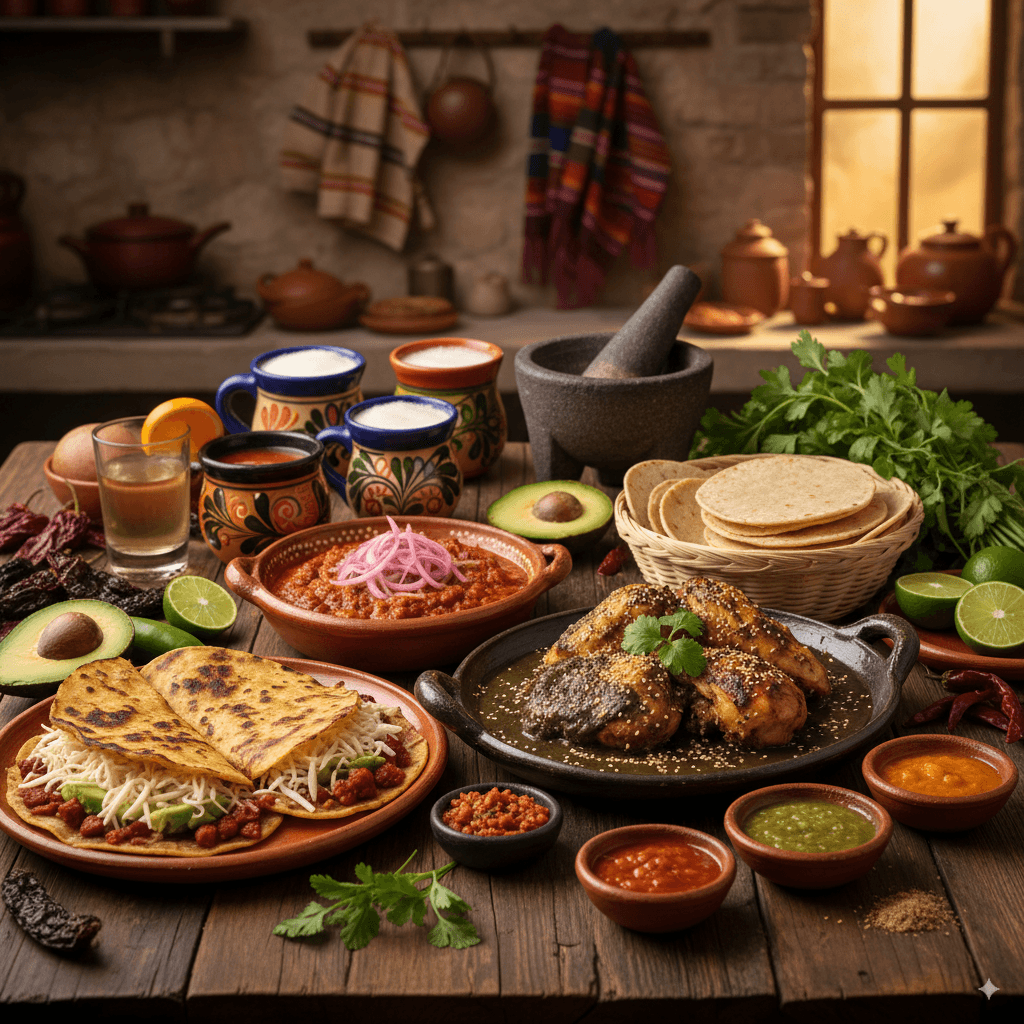Where centuries-old culinary traditions tell the story of a nation through its flavors
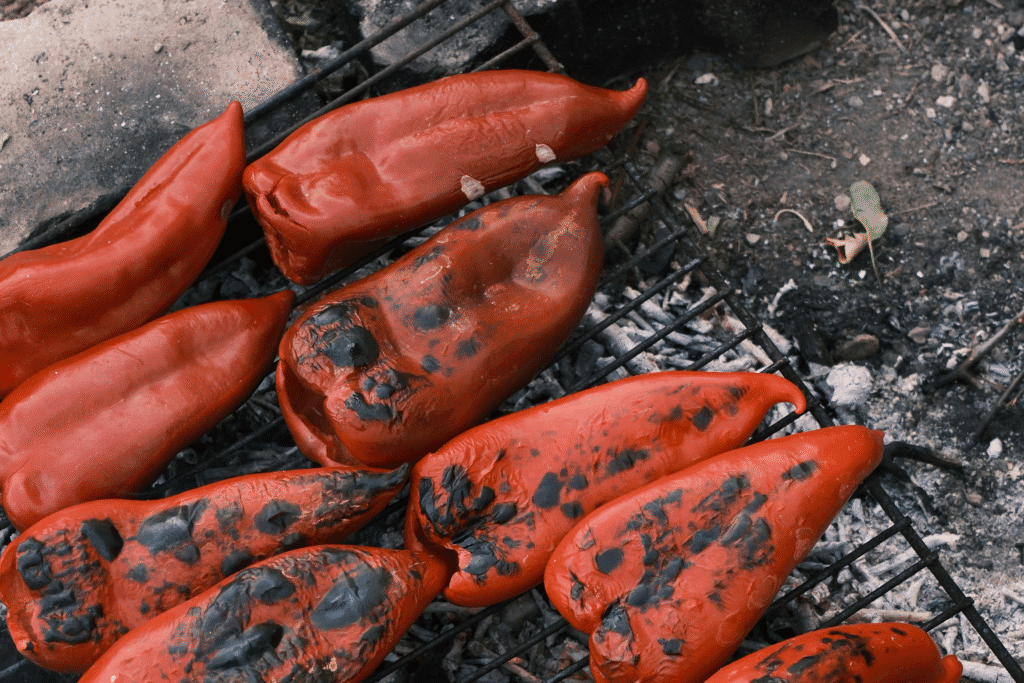
Mexico has amazing beaches and extraordinarily rich culture, but the food… oh my, the food! The scent of toasting chiles wafts through the air as I navigate the labyrinthine aisles of Oaxaca’s Mercado 20 de Noviembre. Beside me, an elderly woman grinds chocolate on a metate, the smooth stone worn from decades of use. Her hands work with the practiced rhythm of someone performing not just a task, but a cultural ritual that connects her to generations past. You need to venture beyond the resorts just for this—Mexican cuisine at its source, not as a tourist attraction, but as a living, breathing cultural heritage so profound that UNESCO recognized it as an Intangible Cultural Heritage of Humanity in 2010.
Mexico’s culinary landscape is as diverse as its geography, with each region offering distinct flavors shaped by history, indigenous traditions, colonial influences, and local ecosystems. To truly understand Mexican food is to embark on a journey far beyond the familiar comfort of tacos and guacamole, delving into a complex tapestry of tastes that tell the story of this multifaceted nation.
A Culinary Heritage Centuries in the Making
Long before Spanish conquest brought European ingredients to Mexico’s shores, indigenous cooks had developed sophisticated culinary traditions centered around corn, beans, chiles, tomatoes, and cacao. These native ingredients – many of which have since transformed global cuisine – remain the foundation of authentic Mexican cooking.
“Mexican cuisine is a continuous dialogue between the ancestral and the contemporary,” explains Diana Kennedy, the renowned cookbook author who has spent decades documenting Mexico’s traditional recipes. This dialogue becomes evident as you travel through the country’s distinct culinary regions, each with its own unique approach to this shared culinary language.

Oaxaca: Land of Seven Moles
In the southern highlands of Oaxaca, cuisine reaches an almost religious significance. Here, the complex, labor-intensive moles reign supreme – not just the familiar mole negro with its deep chocolate undertones, but seven distinct varieties, each requiring dozens of ingredients and hours of preparation.
At the heart of Oaxacan cuisine lies the concept of “nixtamalization,” the ancient process of treating corn with lime to enhance its nutritional value and flavor. This technique, developed by pre-Hispanic indigenous communities, transforms corn into the foundation for everything from the simple street food tlayudas (oversized tortillas topped with beans, cheese, and meat) to complex festive dishes.
Market Guide: At Mercado Benito Juárez, look for quesillo (Oaxacan string cheese), chapulines (toasted grasshoppers), and the dizzying array of chiles specific to regional moles. Engage vendors by asking about cooking methods rather than prices initially – respect earns respect in these traditional spaces.
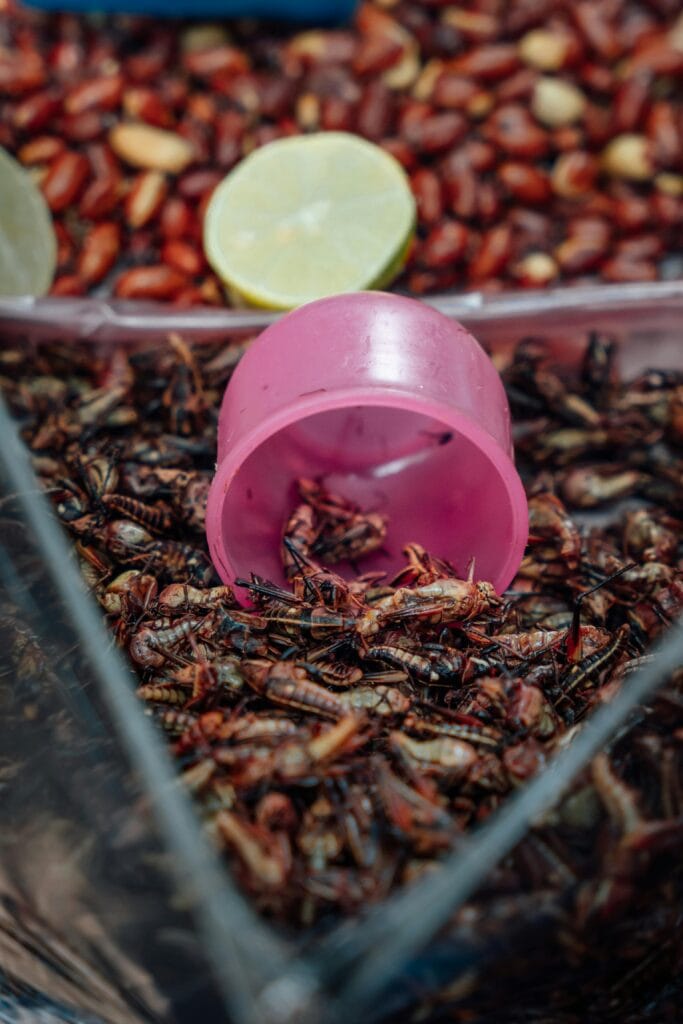
Yucatán Peninsula: Maya Meets Mediterranean
Travel east to the limestone flatlands of the Yucatán Peninsula, and the cuisine transforms dramatically. Here, Maya culinary traditions blend with influences from Europe, the Caribbean, and the Middle East to create dishes found nowhere else in Mexico.
The defining flavor of Yucatecan cuisine comes from achiote (annatto), a seed that imparts a distinctive rusty-red color and subtle earthy flavor to dishes like cochinita pibil – slow-roasted pork marinated in sour orange juice and achiote paste, traditionally cooked in underground pits.
The region’s isolation from central Mexico allowed for the development of unique preparations, including papadzules (tortillas filled with hard-boiled eggs and bathed in pumpkin seed sauce) and sopa de lima (lime soup with turkey or chicken). The abundant coastline also means seafood features prominently, often prepared with distinctly local methods.
Market Guide: In Mérida’s Lucas de Gálvez market, seek out recados (spice pastes) in various colors – red (recado rojo), black (recado negro), and green (recado verde) – each forming the base for different regional specialties. Don’t miss locally produced honey, prized for its complex flavors derived from peninsula flora.
Northern Mexico: The Grilling Grounds
The arid expanses of northern Mexico developed a cuisine distinctly different from the country’s central and southern regions. Here, where cattle ranching has thrived since colonial times, beef takes center stage, often prepared with minimal seasoning over open flames.
“Northern Mexican cuisine celebrates the ingredient itself,” says Monterrey-based chef Guillermo González Beristáin. “Our cooking is about respecting the natural flavor of exceptional products rather than masking them with complex sauces.”
This respect for ingredients manifests in dishes like carne asada, arrachera (flank steak), and cabrito (milk-fed kid goat), often accompanied by flour tortillas – a regional preference that distinguishes northern tables from the corn tortilla traditions prevalent elsewhere.
Market Guide: At Monterrey’s Mercado Juárez, quality matters more than variety. Look for regionally produced cheeses like queso menonita (similar to a mild cheddar, developed by Mennonite communities in Chihuahua) and locally raised beef. Early mornings yield the freshest selection of machaca (dried shredded beef), an essential northern staple.
Pacific Coast: The Seafood Corridor
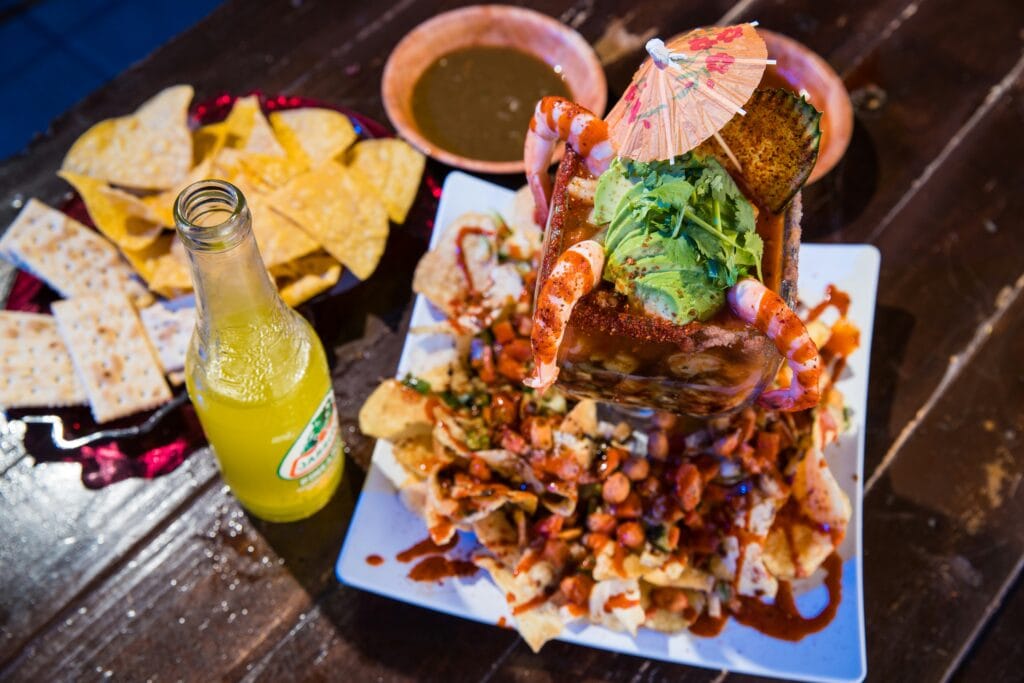
Mexico’s extensive Pacific coastline, stretching from Baja California to Chiapas, offers a paradise for seafood lovers. Each coastal region has developed distinctive preparations reflecting local catches and cultural influences.
In Sinaloa, aguachile presents raw shrimp marinated in lime juice with chiles, cucumber, and onion – a coastal cousin to ceviche that exemplifies the region’s preference for bright, direct flavors. Further south in Guerrero, pescado a la talla features whole fish butterflied and grilled over mangrove wood after being coated with a chile-based marinade.
Perhaps no coastal dish better represents Mexico’s ingenious approach to local ingredients than tiritas de pescado from Zihuatanejo – thin strips of fresh fish marinated briefly in lime juice with red onions, chiles, and salt. Created by fishermen looking to make a quick meal on their boats, this dish perfectly captures the Mexican talent for transforming simplicity into culinary brilliance.
Market Guide: When visiting coastal markets like Mazatlán’s Mercado Pino Suárez, timing is everything. Arrive between 7-9 am when fishing boats deliver their morning catch. Look for fish with clear eyes and firm flesh, and don’t hesitate to ask vendors where the catch came from – they take pride in their sourcing knowledge.
Central Highlands: The Cradle of Corn
The fertile valleys of central Mexico—encompassing states like Puebla, Tlaxcala, and Mexico State—represent the historical heart of Mexican cuisine. Here, ancient agricultural traditions continue in the cultivation of corn varieties in every color from deep blue to crimson red, each with distinctive flavors and culinary applications.
Puebla’s cuisine stands out for its sophisticated blending of indigenous and European techniques, exemplified by its most famous contribution: mole poblano. This complex sauce, containing chocolate and dozens of other ingredients, embodies the region’s colonial history while maintaining deep pre-Hispanic roots.
The volcanic soil of the central highlands also produces some of Mexico’s most distinctive ingredients, including the coveted huitlacoche (corn fungus) and flor de calabaza (squash blossoms), both showcased in delicate quesadillas and soups throughout the region.
Market Guide: The sprawling Mercado de la Merced in Mexico City overwhelms first-time visitors. Start in the dried chile section to appreciate the diversity of these essential ingredients. Look for seasonal delicacies like escamoles (ant larvae) in spring and chapulines (grasshoppers) in summer. Purchase herbs in small quantities, as their potency far exceeds what you might find elsewhere.
Indigenous Ingredients: The Foundation of Flavor
Mexican cuisine’s remarkable diversity stems from its wealth of indigenous ingredients, many of which are only beginning to gain recognition beyond Mexico’s borders. These native foods aren’t merely cooking components—they represent cultural heritage, ecological adaptations, and ancient agricultural wisdom.
The Holy Trinity and Beyond
Corn, beans, and squash—often called the “Three Sisters” for their complementary growing patterns—formed the nutritional foundation of pre-Hispanic Mexico. Traditional milpa farming combines these crops in a sustainable system that enriches rather than depletes soil nutrients.
Beyond these staples, Mexico’s biodiversity contributes thousands of unique ingredients to its cuisine:
- Quelites: Wild greens gathered seasonally, including verdolagas (purslane), huauzontle (similar to amaranth), and epazote (an herb essential to bean dishes)
- Chiles: Hundreds of varieties beyond the familiar jalapeño and poblano, including rare specimens like chile de agua in Oaxaca or chile xcatic in Yucatán
- Fruits: Native species from mamey sapote to guanábana (soursop) that feature in everything from desserts to savory moles
- Insects: Protein-rich traditional foods including escamoles, chapulines, and chicatanas (flying ants), harvested seasonally and prepared with techniques passed down through generations
“These ingredients aren’t exotic to us—they’re our heritage,” explains ethnobotanist Aída Gálvez of UNAM. “Each chile variety or wild green represents centuries of agricultural selection and cultural knowledge. When these ingredients disappear, we lose not just flavors but connections to our ancestors.”
Street Food: The Democracy of Deliciousness
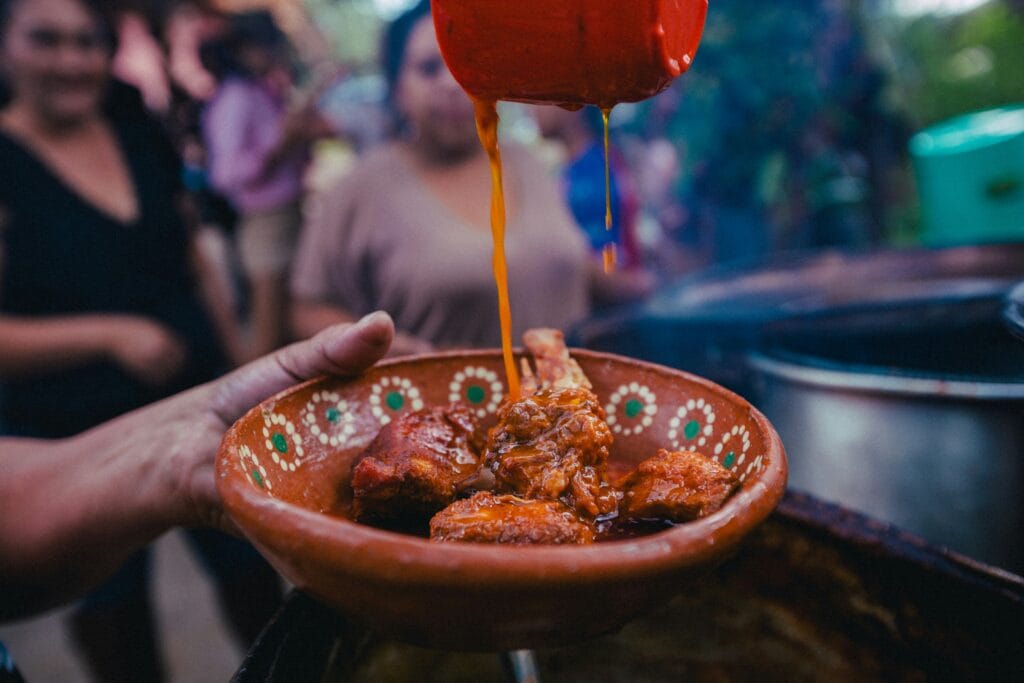
No exploration of Mexican cuisine would be complete without venturing into its vibrant street food culture, where some of the country’s most extraordinary flavors emerge from humble carts and stalls.
Street food in Mexico represents culinary democracy—dishes developed by ordinary people, often women supporting their families, who transformed necessity into art through ingenuity and skill. Regional variations abound, from Mexico City’s tlacoyos (oval masa cakes stuffed with beans or cheese) to Guadalajara’s tortas ahogadas (sandwiches “drowned” in spicy sauce).
Safety Considerations
While street food inspires understandable caution among travelers, following a few guidelines can help you enjoy these culinary treasures safely:
- Look for crowds: Popular stands with high turnover ensure freshness.
- Observe hygiene practices: Watch for vendors who handle money and food separately, keep ingredients covered, and maintain clean workspaces.
- Start gradually: Begin with fully cooked items like tacos dorados (fried tacos) or quesadillas before trying raw preparations like aguachiles.
- Follow local patterns: If you see families with children eating somewhere, it’s generally a good sign.
- Trust your instincts: If something doesn’t feel right, simply move on to another option.
Traditional Cooking Methods: Ancient Techniques, Timeless Flavors
Mexican cuisine’s distinctive character derives not just from its ingredients but from cooking methods that pre-date European contact—techniques that modern chefs worldwide now study and emulate.
The cornerstone of traditional Mexican cooking is the comal, a flat griddle traditionally made of clay but now often metal, used for everything from toasting chiles to cooking tortillas. This simple tool, found in kitchens throughout Mexico, connects contemporary cooks to practices thousands of years old.
Other ancient techniques continue to define regional cuisines:
- Pib cooking: In Yucatán, underground pit ovens slowly roast meats wrapped in banana leaves, imparting a distinctive earthy flavor impossible to achieve with modern methods.
- Mixiote: Central Mexican technique of wrapping seasoned meat in maguey leaf packets before slow-steaming, concentrating flavors while keeping the protein moist.
- Rescoldo: In rural areas, cooking directly in hot embers gives vegetables like onions and corn a distinctive char while preserving internal sweetness.
These methods aren’t merely nostalgic practices but techniques that produce unique flavors unachievable through modern shortcuts. Their preservation represents both culinary wisdom and cultural continuity.
Family Recipes: The True Keepers of Tradition
Behind every regional specialty lies countless family variations, each household maintaining its own precise formula for the perfect mole or the ideal chiles rellenos. These family recipes, often undocumented but preserved through observation and practice, represent Mexican cuisine’s true soul.
In Michoacán, Doña Esperanza Medina has prepared carnitas for Sunday family gatherings for over fifty years, using copper cauldrons and a technique handed down from her grandmother. The specific ratio of orange peel to cinnamon in her marinade remains unwritten but precise in her practiced hands.
“Recipes don’t exist on paper for us,” she says, turning chunks of pork with practiced ease. “They live in our senses—how something should smell at each stage, how the color changes, how the sound of bubbling shifts. These things cannot be written.”
This sensory understanding represents the greatest challenge in preserving authentic Mexican cuisine—the knowledge that resides not in measurements but in accumulated experience passed from generation to generation.
Beyond Tequila and Mezcal: Mexico’s Diverse Drinking Traditions
While tequila and mezcal have captured global attention, Mexico’s beverage traditions extend far beyond these agave spirits. Regional drinks offer insight into local ingredients and cultural values, from ceremonial preparations to everyday refreshments.
In central Mexico, pulque—a mildly fermented agave drink with pre-Hispanic roots—continues to be produced using ancient methods. This living beverage, still fermenting when served, traditionally connects consumers to the land from which it comes.
The tropical south offers refreshing aguas frescas made from local fruits like ciruela (Mexican plum) and mamey, while Yucatán specializes in xtabentún, an anise liqueur made with honey produced by bees that feed on native flowers.
Even coffee traditions vary dramatically by region. In Veracruz, café con leche incorporates cinnamon and piloncillo (unrefined cane sugar), while Chiapas produces some of Mexico’s finest single-origin beans, increasingly recognized in international specialty coffee markets.
Ethical Food Tourism: Respecting Culinary Heritage
As interest in authentic Mexican cuisine grows, thoughtful travelers must consider how their food exploration impacts communities and traditions. Ethical culinary tourism supports local economies while respecting cultural ownership.
Principles for Respectful Culinary Exploration:
- Acknowledge origins: Recognize that dishes have specific regional and cultural roots rather than treating “Mexican food” as a homogeneous category.
- Compensate fairly: Be willing to pay appropriate prices for labor-intensive traditional foods rather than expecting artificial “local rates.”
- Ask permission: Always request consent before photographing cooks or their processes, especially in communities where recipes represent proprietary knowledge.
- Learn basic terminology: Familiarize yourself with essential food vocabulary in Spanish as a sign of respect.
- Share with intention: When discussing Mexican cuisine, avoid exoticizing ingredients or preparations that have sustained communities for centuries.
Resources for Deeper Exploration
For travelers seeking more immersive culinary experiences, Mexico offers abundant opportunities to engage with food traditions beyond restaurant meals:
Cooking Classes:
- Mexico City: La Casa de los Sabores offers market tours followed by hands-on instruction in classic central Mexican techniques.
- Oaxaca: Seasons of My Heart cooking school, founded by chef Susana Trilling, teaches traditional Oaxacan preparations with an emphasis on cultural context.
- Mérida: Los Dos Cooking School specializes in Yucatecan cuisine, including both Maya and colonial influences.
Food Tours:
- Puebla: Taste of Puebla walking tours explore the city’s contributions to Mexican cuisine, including the origins of classic dishes like chiles en nogada.
- Ensenada: Baja Taste takes visitors through the region’s booming culinary scene, from street tacos to the innovative “Baja Med” fusion movement.
- Mexico City: Eat Like a Local focuses on family-run establishments and street vendors typically overlooked by conventional tourism.
Further Reading:
- Diana Kennedy’s collection of cookbooks, particularly The Essential Cuisines of Mexico
- Margarita Carrillo Arronte’s Mexico: The Cookbook
- Yuri de Gortari and Edmundo Escamilla’s Tacopedia
The Endless Culinary Journey

Mexico’s cuisine defies simple categorization or complete exploration. Each visit reveals new dimensions of flavor, history, and cultural significance. The most authentic dishes often remain undocumented, existing only in the practiced hands and discerning palates of those who prepare them.
“To truly understand Mexican food is to accept that you will always be learning,” says chef Enrique Olvera, whose restaurants have helped bring Mexican cuisine to international prominence. “The diversity is infinite because it’s not just about recipes but about people and their relationships with their environment.”
This perspective offers the most rewarding approach for culinary travelers: embrace the journey rather than seeking definitive expertise. Allow each meal to tell its story, each cook to share their heritage, and each region to reveal its unique relationship with food.
In doing so, you’ll discover that beyond the familiar flavors lies a culinary universe of extraordinary depth—one that continues to evolve while remaining deeply rooted in traditions that have sustained Mexican communities for millennia.
Have you experienced a regional Mexican dish that transformed your understanding of the country’s cuisine? Share your story in the comments below, or join our community forum for recommendations on discovering authentic flavors during your travels.

